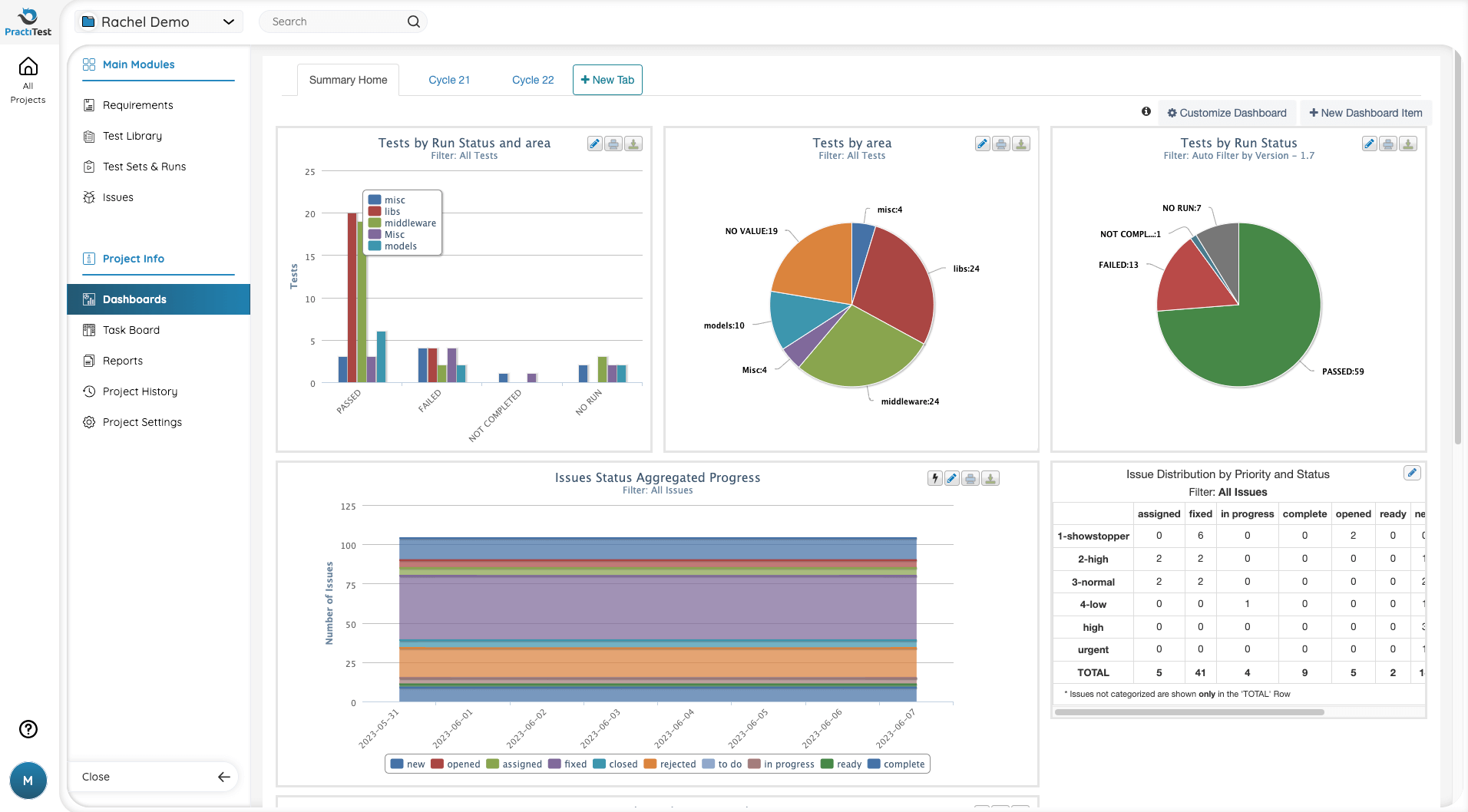Software Testing Best Practices Checklist
In This blog
The software testing process can often be a bit of a puzzle. There are so many pieces that must fit together - teams, tools, documentation, and many other components. Software testers and managers often feel like they’re navigating a maze when trying to coordinate these complex elements. To help software testers ensure they’re on the right track, we’ve created an extensive checklist with the best software tips and practices.

#1: Understanding Requirements & Defining Clear Objectives
Software testing starts with a clear understanding of your testing goals and the project’s requirements. Think of it as setting the course for your journey. Learn the product, gain insights into its intended functionality, and identify its user base. For an in-depth comprehension of the software’s anticipated behavior, lean on the Software Requirement Specification document (SRS). This document serves as your compass, guiding you on the path to effective testing.
Then, once you have established some knowledge, it’s time to set the objectives you would like to achieve. Define what needs to be tested and establish the scope of your testing efforts. Look for certain areas that will probably require more comprehensive testing and verify you can cover them. This clarity ensures you’re on the right path to effectively assess the software’s quality and functionality.
#2: Test Planning & Strategy
After defining clear goals, now it’s time to develop a comprehensive test plan that will help achieve them. This document serves as the guide to your efforts and outlines your testing scope, types, and techniques that you’ll use. The test plan catalogs the necessary resources you have and need, including personnel and testing tools. As it sets the rhythm of your testing, it should have a precise schedule of activities.
It’s important to ensure that your testing strategy includes risks. Just like any other project, testing has risks, as some areas of the software are more prone to errors and at a higher risk of containing severe defects. Try to prioritize your testing based on a risk-based assessment and invest resources in those areas. Finally and most importantly, keep your goals measurable: this a crucial aspect to consider that will become super handy later in the project (wait for tip no. #10).
#3: Test Case Designing
The next step to take is designing detailed test cases. From straightforward, simple interactions with the system to more complex scenarios, ensure your test cases encompass the full spectrum of possibilities. Make your test cases clear, with defined steps and expected results, in order to validate that the software behaves as required in real life scenarios.
This is critical for achieving comprehensive testing coverage so that no potential scenarios are left unexplored. The more thorough and detailed your test cases, the better your coverage, and the more confident you can be in the quality of the software you’re testing.
#4: Early Testing & Modern Methodologies
Are you familiar with the saying, “the early bird catches the worm”? In software testing, it holds true. Starting testing in the early stages of software development can be extremely valuable in releasing higher quality software to your clients. This approach is also known as “shifting left”, which enables us to catch and eliminate defects earlier, before they make their way to end users and cause a negative experience. In addition, catching bugs during those early stages is less costly to fix than if discovered at a later point.
Early testing aligns seamlessly with modern methodologies and can significantly impact the efficiency and effectiveness of your testing efforts. Adopting methodologies like Agile and DevOps can help you ensure that testing becomes an integral part of the software’s journey from inception to delivery. In doing so, you pave the way for higher quality software with greater flexibility, better collaboration among departments, and meeting user expectations by putting your customer at the center.
#5: Combine Different Testing Types
Software has multiple layers to consider during development. As testers, we need to verify that those layers are also covered in the testing process from A to Z. Therefore, QA efforts should combine different testing types and levels. Beginning with functional testing, the purpose is to assess whether the software performs its intended functions. You should use different functional testing types such as unit testing, integration testing, and smoke testing, to verify the functionality from multiple angles.
Non-functional testing which delves into things like performance, usability, and reliability are also critical and should be performed. With the increasing number of cybersecurity threats, teams are aware of the importance of executing comprehensive security testing to ensure there are no vulnerabilities in the software. Finally, regression testing has a vital role too, verifying that new code changes haven’t disrupted existing functionalities.
By embracing the spectrum of testing types, you’re fortifying your software from all angles, ensuring it’s a fortress of quality.
#6: Report Bugs Effectively
Bug reporting is one of the core fundamentals of the testing process, ensuring that issues are not only identified, but resolved promptly. When you discover a bug, it’s crucial to raise the flag on time and categorize it by severity. Just as tests get prioritized based on high risk areas, bugs should be classified based on their impact on the software’s functionality and end-user experience. This categorization helps in prioritizing the bugs that require immediate attention, ensuring that critical issues are swiftly addressed without wasting time on resolving harmless defects.
The way to master bug reporting is through effective communication. By conducting regular team meetings and fostering open lines of communication, you can ensure that bugs won’t slip through the cracks and that every issue is addressed, contributing to a smoother and more efficient testing process. Make sure to include clear and concise details in your bug reports, including steps to reproduce, expected results, and actual outcomes. Emphasize the bug’s impact on the software’s functionality and its implications for the end user.
#7: Involve Non-Testers in Testing Efforts
As the primary goal is to deliver a top-quality product to your customers, it’s best to step into the shoes of your end-users and imitate a real-life environment. By involving developers, product owners, business analysts, and other team members who don’t traditionally bear the “tester” title, you open the door to a world of diverse insights and valuable skill sets that can only contribute to your product’s quality. According to the 2023 State of Testing survey, 33% of the respondents claimed that 10%-50% of their testing efforts are performed by non-dedicated testers.
Developers, for example, serve as the architects of the software and can provide a unique technical perspective, identifying issues from a code-level vantage point. Product owners, on the other hand, bring their rich knowledge of user requirements and expectations, ensuring that the software aligns with the user’s vision.
Each of these non-testers offer a distinctive viewpoint, and their participation enriches the testing process. By breaking down silos and fostering collaboration among team members, you can identify and address issues from multiple angles, resulting in a more comprehensive and effective testing effort.
#8: Use Automation Testing Wisely
Although automation is a powerful tool for software testing, like any powerful tool, it must be used intelligently. Regular usage of automation testing can be a game-changer, particularly when it comes to repetitive, complex, or time consuming tests. It’s capable of significantly reducing testing times compared to manual testing, eliminating the risk of human error and delivering reliable results.
However, it’s important to remember that you can not automate 100% of your testing. While it excels in some scenarios, there are tests where the human eye and intellect remain indispensable. For example, accessibility testing, which gauges how people with disabilities interact with your software, requires the sensitivity and judgment of a human tester. Similarly, exploratory testing, where testers explore the software freely to uncover uncharted issues, relies on the intuition and creativity of a human tester. The key lies in using automation where it shines and complementing it with manual testing where human judgment and experience are irreplaceable.
#9: Manage Testing Using a Test Management Platform
In a modern testing environment where complexity is high but teams have to release software as fast as possible, the main way to keep up the pace is with effective QA management. That’s where a dedicated test management platform such as PractiTest steps in. This platform serves as a centralized repository for all teams and consolidates multiple testing artifacts including requirements, test cases, and bugs into a centralized hub. Managing QA this way makes your processes much more efficient, and goes hand in hand with modern agile approaches.
Test management tools also have robust integration capabilities with a spectrum of tools used across your organization, including bug trackers, project management platforms, automation tools, and CI/CD tools. This assists in streamlining workflows, allowing for a more agile and efficient testing process. These tools offer enhanced visibility and traceability, providing real-time insights into the testing landscape through customizable dashboards and comprehensive reports. This data-driven approach empowers your team to make informed decisions and respond quickly to testing challenges.

#10: Measure All the Time!
Testing is a dynamic process that thrives on continuous improvement. This can only be achieved with consistent measurement and analysis. By using key metrics, you empower your team to identify weaker areas needing enhancement, collaborate more effectively, and steer the ship to the right direction.
Measuring testing efforts isn’t merely about tallying up numbers; it’s about learning and evolving. For that, you need more than numbers. Instead of looking at the number of bugs for example, calculate the number of escaped defects (aka Escaping Defects Index) to understand how many defects were caught by end-users, which may indicate the quality of your testing. You can use our guide “Measuring QA Contribution to Your Business” to learn more about the most recommended software testing metrics.























